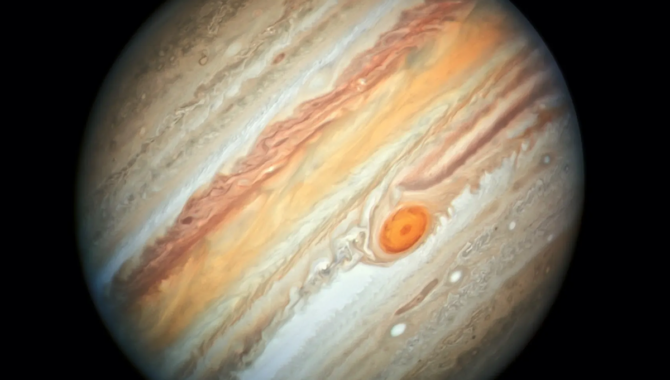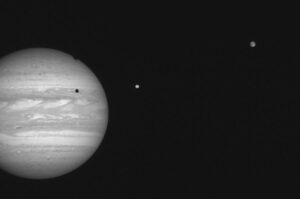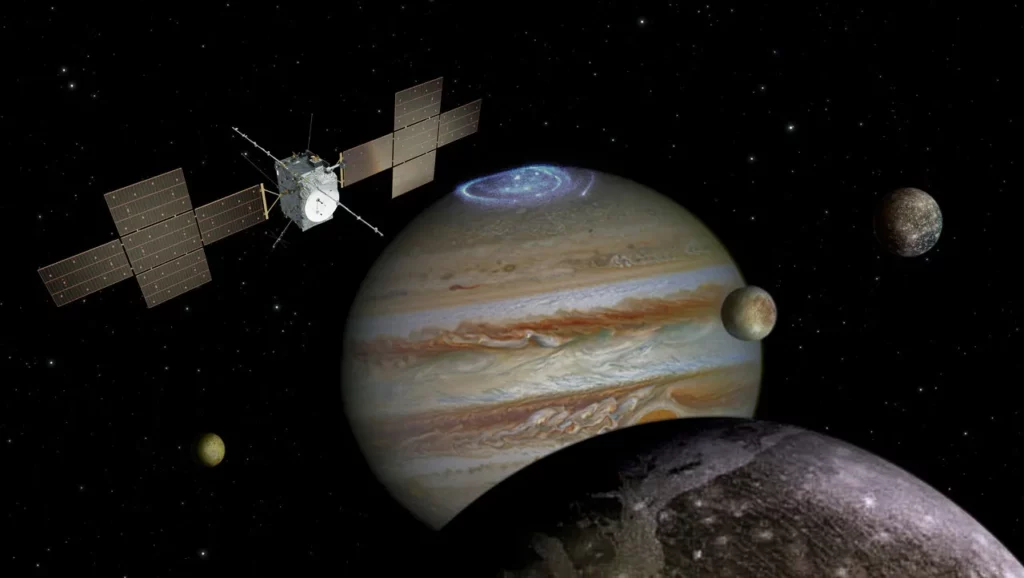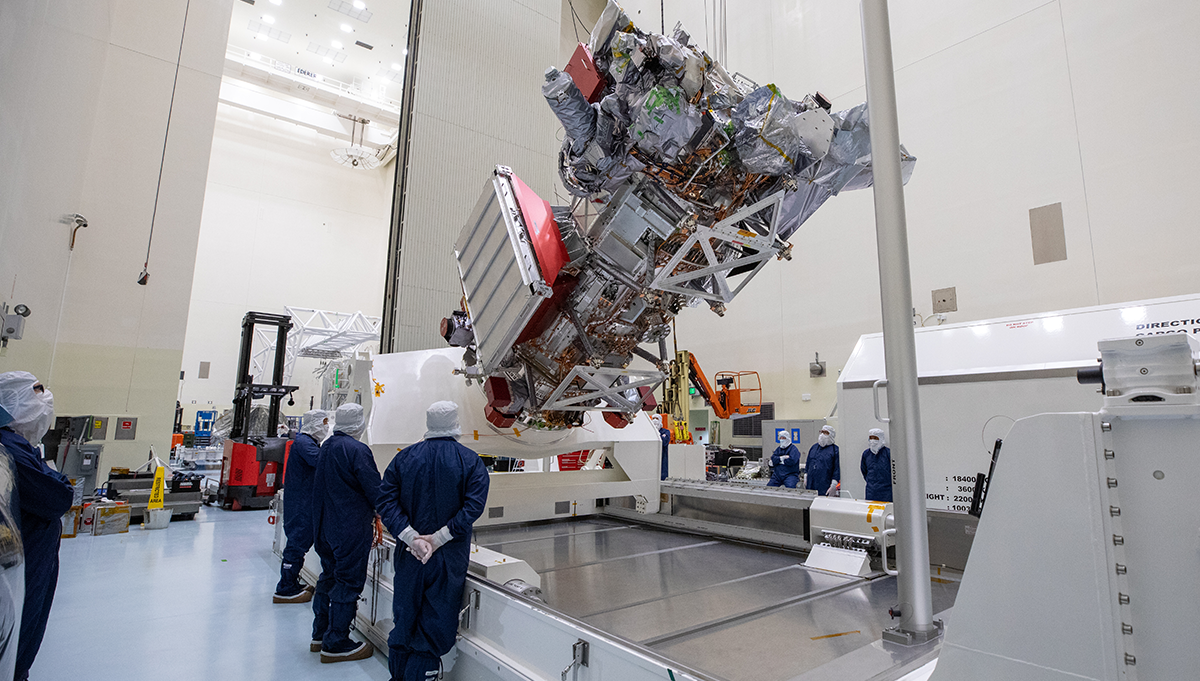
Although astronomers have been observing Jupiter for hundreds of years, there’s still a lot to learn about this mysterious world, where swirling storms roil the already turbulent atmosphere. Jupiter and its largest moons will come into sharper focus in the early 2030s, with the arrival of two new spacecraft. Credits: NASA, ESA, A. Simon (Goddard Space Flight Center), and M.H. Wong (University of California, Berkeley)
New spacecraft to gather data on complex Jovian system and three icy moons that could contain vast oceans.
The Galilean Moons of Jupiter will come into much sharper focus in the 2030s, as two spacecraft begin returning data from ambitious missions to explore the Jovian system.
NASA’s Europa Clipper, which teams are preparing to launch in October, will focus primarily on Europa, making dozens of passes by the icy moon as the spacecraft orbits Jupiter. The European Space Agency’s (ESA) Jupiter Icy Moons Explorer (JUICE) mission will focus on Ganymede, Callisto and Europa. Scientists believe the three moons likely contain large oceans beneath thick ice, and perhaps other building blocks for life.
“…We have sent a suite of ground-breaking science instruments on a journey to Jupiter’s moons that will give us an exquisite close-up view that would have been unimaginable to previous generations,” said Carole Mundell, ESA’s Director of Science, in an ESA press release following the April 14, 2023, launch of JUICE from Europe’s Spaceport in French Guiana aboard an Ariane 5 rocket.
On August 20, JUICE became the first spacecraft to execute a complex gravity assist from both the Moon and Earth. The assist slowed the spacecraft and directed it through the inner solar system toward Venus, which it will reach in mid-2025 for another gravity assist. Juice will pick up two additional gravity assists from Earth during a 4.1-billion-mile journey, reaching Jupiter in 2031.
“Hundreds of millions of kilometers from Earth and powered by just a sliver of sunlight, we will guide Juice through 35 flybys of Jupiter’s ocean moons in order to gather the data needed to bring scientists closer than ever to these compelling destinations,” said Ignacio Tanco, ESA’s JUICE spacecraft operations manager, in the press release.
The spacecraft is roughly a cube, 16.8 m tall and 13.7 m deep, with large solar panels on each side extending the width to 27.1 m. The panels contain 23,560 thin-film, high-efficiency solar cells optimized to produce 850 watts of power in the weak sunlight and extremely cold temperatures at Jupiter. JUICE’s wet mass of 6,000 kg at launch included 3,650 kg of chemical propellant for maneuvers and orbital insertions.

The ten instruments and one experiment on JUICE make up the most powerful remote sensing, geophysical, and in situ payload complement ever flown to the outer Solar System. Credit: ESA
JUICE carries a suite of sophisticated instruments to gather data from Jupiter’s moons, which were first observed by Italian astronomer Galiel Galileo between December 1609 and January 1610. Thought to be stars for several months after their discovery, the moons intrigue scientists today because of growing evidence they may contain massive oceans, internal heat sources, and the organic compounds that gave rise to life on Earth.
NASA contributed the UV imaging Spectrograph (UVS) for the mission. It is part of a remote sensing package that includes the JANUS optical camera system, the Moons and Jupiter Imaging Spectrometer (MAJIS), and the Sub-millimeter Wave Instrument (SWI). Together, the package will provide broad imaging and spectral imaging capabilities.
NASA also contributed key components for the RIME (Radar for Icy Moon Exploration) instrument. RIME will emit radio waves that can penetrate approximately six miles into the icy surfaces of Ganymede, Callisto and Europa. How those waves penetrate and bounce back will give scientists a better idea of the ice, its thickness, the prevalence of deep cracks, and the conditions beneath it.
RIME is part of a geophysical package that includes GALA, the Ganymede Laser Altimeter, and an instrument known as 3GM, which will gather date about the atmosphere of Jupiter and the three moons and measure their gravity fields.
The rest of JUICE’s instruments are in the “in situ package” which will measure the dynamic radio emissions, plasma waves and particle environment at Jupiter, where energetic particles can approach the speed of light.

Two of Jupiter’s moons, Io and Ganymede. Credit: NASA/Johns Hopkins University Applied Physics Laboratory/Southwest Research Institute
During the August gravity assist, the team used the opportunity to test and calibrate JUICE’s instruments, including the MAJIS and SWI spectrometers, collecting data from Earth. SWI detected signals for water, carbon, hydrogen, nitrogen, oxygen, phosphorus and sulfur. MAJIS gathered data on Earth’s oxygen-rich atmosphere and moderate temperatures. The team concluded that Earth is habitable, but more importantly that the instruments work in space as designed.
The mission seeks to characterize Jupiter’s ocean moons, and gather data that could indicate if they are, or ever were, habitable. JUICE’s data will also give new insights into the complex Jovian system, with at least 95 moons orbiting a gas giant planet so massive it could contain the rest of the planets in our solar system within it.
Plans call for JUICE to be inserted in orbit at Jupiter in July 2031. In late 2033, the mission focus will shift specifically to Ganymede, the largest moon in our solar system. JUICE will become the first spacecraft to orbit a moon in the outer solar system, orbiting Ganymede for nearly a year.
“The scientific treasure that will be returned will undoubtedly have far-reaching implications on how we understand our Solar System and if there are potentially habitable locations beyond Earth – not just in our own cosmic neighborhood but also well beyond in the vast number of exoplanet systems populating our Universe,” said Olivier Witasse, ESA’s Juice project scientist.










